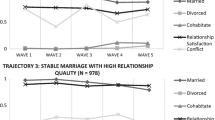Abstract
This study tested Rusbult’s (1980, 1983) investment model of relationship commitment and stability using data from both partners of 3,627 married couples. As pre-dicted, spouses’ satisfaction, investments, and quality of alternatives were unique predictors of their commitment to the marital relationship. Additionally, commitment assessed at the initial testing predicted marital termination or stability 18 months later. Multiple-group path analyses showed that the investment model provided an adequate fit to the data and that the associations among variables were similar for husbands and wives. Limitations of the model as well as directions for future research are consid-ered.
Article PDF
Similar content being viewed by others
References
Adams, J. M., & Jones, W. H. (1997). The conceptualization of marital commitment: An integrative analysis. Journal of Personality and Social Psychology, 72, 1177–1196.
Beals, K. P., Impett, E. A., & Peplau, L. A. (In press). Lesbians in love: Why some relationships endure and others end. The Journal of Lesbian Studies.
Bentler, P. M. (1990). Comparative fit indexes in structural models. Psychological Bulletin, 107, 238–246.
Bentler, P. M. (1995). EQS structural equations program manual. Encino, CA: Multivariate Software, Inc.
Blumstein, P., & Schwartz, P. (1983). American couples. New York: William Morrow.
Bradbury, T. N. (In press). Research on relationships as a prelude to action. Journal of Social and Personal Relationships.
Bui, K. T., Peplau, L. A., & Hill, C. T. (1996). Testing the Rusbult model of relationship commitment and stability in a 15-year study of heterosexual couples. Personality and Social Psychology Bulletin, 22, 1244–1257.
Browne, M. W., & Cudeck, R. (1993). Alternative ways of assessing model fit. In K. A. Bollen & J. S. Long (Eds.), Testing structural equation models (pp. 136–162). Newbury Park, CA: Sage.
Byrne, B. M. (1994). Structural equation modeling with EQS and EQS/Windows. Thousand Oaks, CA: Sage.
Duffy, S. M., & Rusbult, C. E. (1992). Satisfaction and commitment in homosexual and heterosexual relationships. Journal of Homosexuality, 12(2), 1–23.
Johnson, M. P., Caughlin, J. P., & Huston, T. L. (1999). The tripartite nature of marital commitment: Personal, moral, and structural reasons to stay married. Journal of Marriage and the Family, 61, 160–177.
Karney, B. R., & Bradbury, T. N. (1995). The longitudinal course of marital quality and stability: A review of theory, method, and research. Psychological Bulletin, 118, 3–34.
Kelley, H. H., & Thibaut, J. W. (1978). Interpersonal relations: A theory of interdependence. New York: John Wiley.
Lin, Y. W., & Rusbult, C. E. (1995). Commitment to dating relationships and cross-sex friendships in America and China. Journal of Social and Personal Relationships, 12, 7–26.
National Center for Health Statistics. (1990). Advance report of final marriage statistics. Monthly Vital Statistics Report, 38, (Suppl), 1111–1112.
Rusbult, C. E. (1980). Commitment and satisfaction in romantic associations: A test of the investment model. Journal of Experimental Social Psychology, 16, 172–186.
Rusbult, C. E. (1983). A longitudinal test of the investment model: The development (and deterioration) of satisfaction and commitment in heterosexual involvements. Journal of Personality and Social Psychol-ogy,45, 101–117.
Rusbult, C. E., Johnson, D. J., & Morrow, G. D. (1986). Predicting satisfaction and commitment in adult romantic involvements. Social Psychology Quarterly, 39(1), 81–89.
Rusbult, C. E., & Martz, J. M. (1995). Remaining in an abusive relationship: An investment model analysis of nonvoluntary dependence. Personality and Social Psychology Bulletin, 21, 558–571.
Rusbult, C. E., Martz, J. M., & Agnew, C. R. (1998). The investment model scale: Measuring commitment level, satisfaction level, quality of alternatives, and investment size. Personal Relationships, 5, 357–391.
Satorra, A., & Bentler, P. M. (1988). Scaling corrections for statistics in covariance structure analysis. Los Angeles: UCLA Statistics Series, No. 2.
Steiger, J. H., & Lind, J. C. (1980, May). Statistically based tests for the number of common factors. Paper presented at the annual meeting of the Psychometric Society, Iowa City, IA.
Thibaut, J. W., & Kelley, H. H. (1959). The social psychology of groups. New York: John Wiley.
Author information
Authors and Affiliations
Corresponding author
Additional information
This research used the American Couples, 1975-1978, data set [made accessible in 1992, computer data]. These data were collected by Philip Blumstein and Pepper Schwartz and are available through the archive of the Henry A. Murray Research Center of Radcliffe College, Cambridge, Massachusetts (Producer and Distributor). This paper is based on work supported under a National Science Foundation Graduate Fellowship awarded to Emily A. Impett and a UCLA Academic Senate Research Grant to Letitia Anne Peplau. The authors are very grateful to Kevin Kim and Jodie Ullman for statistical consulting and Brian Doss for comments on an earlier draft.
Rights and permissions
About this article
Cite this article
Impett, E.A., Beals, K.P. & Peplau, L.A. Testing the investment model of relationship commitment and stability in a longitudinal study of married couples. Curr Psychol 20, 312–326 (2001). https://doi.org/10.1007/s12144-001-1014-3
Accepted:
Issue Date:
DOI: https://doi.org/10.1007/s12144-001-1014-3




